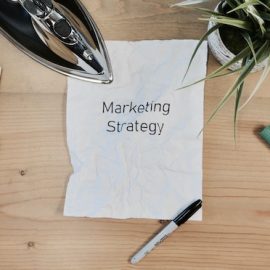

This article gives you a glimpse of what you can learn with Shortform. Shortform has the world’s best guides to 1000+ nonfiction books, plus other resources to help you accelerate your learning.
Want to learn faster and get smarter? Sign up for a free trial here .
Are you trying to find a solution to a dire issue? What are the best problem-solving tools to use?
Problem-solving is something you do every day, whether you notice it or not. Whether you have a broken coffee machine or you’re trying to beat out the competition in the market, there’s always an issue in need of fixing.
We’ll first look at the five steps to problem-solving and then explore problem-solving tools to make the process easier.
The Five Steps to Problem-Solving
Critical thinking helps you learn, understand, and form arguments. Problem-solving incorporates the process of critical thinking but is directed specifically at bridging a gap between your current state and a desired state. For example, you know you currently have a job that you don’t enjoy. Your desired state is to have a job that you do enjoy. The gap—or problem—you need to solve is how to go from having a job you don’t enjoy to having one you do enjoy.
There are five steps to problem-solving, according to Critical Thinking, Logic & Problem.
Step 1: Identify the Problem
To solve a problem, you must first identify it. You can do this using seven basic questions that make up what the authors call the “5W2H” method (five ‘W’ questions and two ‘H’ questions):
- What? What is your current state, your desired state, and the gap between them?
- Where? What is the location of your problem?
- When? When did or does the problem occur? Is it ongoing? Will it happen again in the future?
- Who? Which people are impacted by the problem? Who caused it? Who may know more about it?
- Why? Why did the problem occur or why does it continue to occur? Why is the problem important to address?
- How? How could you solve the problem? What process should you use?
- How much or how many? How big is the problem? How much harm is it causing? How long will it take to solve?
Another tool for defining your problem is what they call the SCQH (Situation, Complications, Question, and Hypothesis) framework. This method helps you analyze a problem fully to point you in the direction of possible solutions. In this method, you’ll follow four steps:
- Situation: Identify your current situation and its context.
- Complications: What things are not working about the situation? (These two steps help you identify the gap between your current state and your desired state).
- Question: What questions do the situation and complication bring up? This will help you clarify the problem and narrow your focus.
- Hypothesis: Come up with some hypotheses that could address your questions. This leads to the next step of identifying potential solutions.
Step 2: Form Solutions
Once you understand the problem you’re facing, you can begin forming solutions by first identifying potential solutions. You can use tools such as logic trees to help you identify solutions.
A logic tree is a tool that allows you to visually lay out potential solutions so you can consider them more easily. You can format the tree in whatever way works best for you, but begin by writing down your problem or question. Then, add branches that show your options and further branches that provide the details of those options, such as benefits, consequences, or other factors to consider. See the example below of a logic tree where the problem is what math class to take as an incoming college freshman, and the possible solutions are calculus, statistics, and trigonometry.
Step 3: Select a Solution
Once you’ve laid out your potential solutions and weighed them against each other, it’s time to select a solution.
One tool you can use to help you choose is a pros and cons assessment. To do this, you can list your pros and cons on a two-column chart and then rate each item based on how important it is. Once you’ve listed all your pros and cons and given them a weight rating, add up the sum for each column and then subtract the cons sum from the pros sum. If the result is a positive number, this suggests the overall benefit of the option outweighs the negatives, making it a good solution to consider.
Step 4: Implement Your Solution
According to the authors, it’s now time to put your solution into action. You can use the 5W2H method again to help implement your plan:
- What solution are you going to implement?
- Why is this the best solution?
- Where will it be implemented?
- When does it need to be implemented?
- Who is going to implement it?
- How will it be implemented?
- How much effort or cost will it require?
Step 5: Evaluate the Results
Finally, the authors advise that you evaluate the results of implementing your solution. Note what went wrong and what went well, and use that information to make better decisions in the future.
Problem-Solving Tools to Make the Process Easier
The above steps lay the groundwork for solving a problem. Next, we’ll look at four tools you can use to make the problem-solving process even easier.
1. The Five Whys
The “Five Whys” Method is a helpful problem-solving tool for finding the root cause of an issue. When you see a problem, ask yourself five Whys in succession.
Here’s an example from Toyota where a machine broke down that The Lean Startup by Eric Ries uses to show the effectiveness of the “Five Whys” Method:
- Why did the machine stop? There was a power overload and the fuse blew.
- If we stopped here, we would just replace the fuse. The fuse would blow again, and we’d replace it again, and so on. We would treat the symptom, but not the cause.
- Why? The bearing was not lubricated.
- Why? The lubrication pump wasn’t pumping.
- Why? The shaft of the pump was worn.
- Why? The mechanic forgot to put a filter on, and metal scrap got in.
The final root cause is dramatically different from what you started with. Because it’s a root cause, addressing it will solve all the problems up the line. If you had stopped asking why at each stage, you’d have addressed only a symptom that will recur, instead of treating the underlying disease.
In fact, if you kept asking why a few more times, you’d probably find other root causes to tackle. The mechanic may have gotten insufficient training on this equipment. Repair of this machine might not have a checklist, which is standard practice. Or the mechanic might have just been a bad hire—in which case bad hiring practices are to blame.
This example can be applied to any recurring problem in your life, whether it’s a problem in your kitchen, customer service, engineering, accounting, or more.
2. Cost-Benefit Analysis
Another effective problem-solving tool is a cost-benefit analysis, which Patrick Bet-David’s Your Next Five Moves and Gabriel Weinberg and Lauren McCann’s Super Thinking: The Big Book of Mental Models both stand by.
A cost-benefit analysis lists the cumulative costs that a decision will incur alongside its cumulative benefits. It thus quantifies the consequences of your decision. At a rudimentary level, a cost-benefit analysis might weigh individual pros and cons on a scale of 10 to -10, summing these values to recommend a decision—if the total is positive, the decision is worthwhile, and if it’s negative, the cost is too high. If you have a pro-con list, you might retool it into the following cost-benefit analysis:
The cost-benefit analysis yields a conclusive verdict: You shouldn’t take a new position, since the cons outweigh the pros. If your problem involves finances, Weinberg and McCann recommend assigning each cost and benefit an explicit monetary value to further improve your analysis. For instance, relocating to a new city might cost $10,000, whereas an extra week of paid leave might be worth $3,000.
To use a cost-benefit analysis, devise three possible solutions to the problem you’ve identified and calculate the investment cost, time cost, and benefits each solution offers, writes Bet-David. Then, compare the calculated costs and benefits of each solution and pick the one that offers the most benefits for the lowest cost.
3. Strategy Chart
In Blue Ocean Strategy, W. Chan Kim and Renée A. Mauborgne present a graphic tool to help you visualize how a product (and the strategy behind it) differs from others in the market. They call this strategy chart a “strategy canvas.” While they present this problem-solving tool in the context of a business selling a product, anyone who is stuck between two or more choices can use this tool. The strategy chart consists of a two-dimensional line graph:
- The horizontal axis lists the characteristics of competition, that is, the attributes of your product and its alternatives that customers consider when making a buying decision. The authors emphasize that it’s important to list only characteristics that customers actually care about.
- The vertical axis represents the emphasis a company places on each characteristic—a higher score indicates a company offers more of that characteristic.
For each product, service, or company that you wish to compare, plot the value of each characteristic on the graph as a point. Then connect the points to produce a strategy curve.
For example:
The blue ocean strategy chart allows you to see at a glance how similar or how different your product’s offerings are. If your curve has a completely different shape from other curves, this implies a unique combination of values.
4. Six Thinking Hats
The Six Hats method asks you to see thinking as mental exploration in a particular direction. In the physical world, you can always check a compass and then deliberately choose to walk to the north, south, east, or west. Think of the six hats as mental compass points. At any point, you can stop and consciously decide on the best course.
Edward De Bono’s six hats represent the following types of thinking, as described in his book Six Thinking Hats:
- The blue hat is for metacognition, or the overall organization of the thinking process.
- The white hat is for gathering neutral information.
- The red hat is for emotions.
- The black hat is for criticism.
- The yellow hat is for positive feedback and developing solutions.
- The green hat is for new, creative ideas.
When you face an important decision, the hats can help you compartmentalize and organize your thinking. In group discussions, the hats help to keep things clear and orderly, as well as making sure that no important ideas are neglected. Here’s an image that helps visualize this problem-solving tool in effect:
Trying to walk north and south at the same time would be pointless and exhausting for your physical body. Similarly, trying to engage in two or more types of thinking at once is inefficient and exhausting for your mind. Your brain works best when it can focus on one type of thinking at a time. If it’s looking for danger, let it look for danger uninterrupted. If it’s creatively breaking existing patterns to make new ones, let it do that. Our normal, untrained thinking is usually a poorly controlled jumble of different types of thinking, and we often rely on pure luck to stumble with solutions.
Think of a drunk person stumbling around an area randomly looking for gold. Now think of an explorer with a compass, systematically walking through the area and sketching out a map as she goes. Who’s more likely to find the gold?
Conducting a systematic mental exploration of the problem allows you to draw a detailed map of the context for any decision you need to make. With this detailed map in hand, your decisions will be so thoroughly considered that the best route will become obvious.
Final Words
These four problem-solving tools can resolve any issue in the workplace or at home. You don’t even have to be an expert to get the job done. The only skills you need are the ones already under your belt.
Which problem-solving tool are you going to try first? Let us know in the comments below!

Want to fast-track your learning? With Shortform, you’ll gain insights you won't find anywhere else .
Here's what you’ll get when you sign up for Shortform :
- Complicated ideas explained in simple and concise ways
- Smart analysis that connects what you’re reading to other key concepts
- Writing with zero fluff because we know how important your time is






